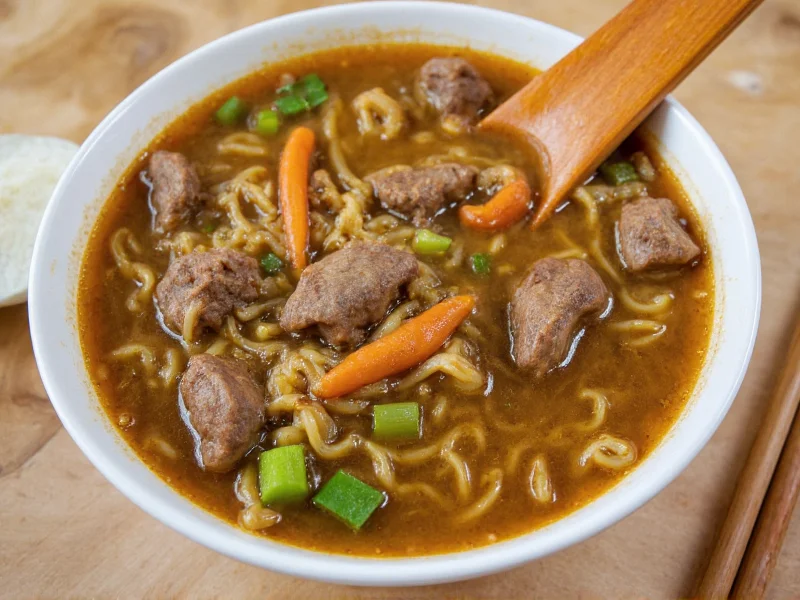The Ultimate Guide to Authentic Beef Noodle Soup
Beef noodle soup represents one of Asia's most beloved comfort foods, with regional variations spanning Chinese, Taiwanese, and Vietnamese culinary traditions. This guide delivers a perfected recipe combining traditional techniques with practical home cooking adaptations. Whether you're craving the spicy Sichuan version or Taiwan's signature red-braised style, mastering this dish begins with understanding its foundational elements.
Essential Ingredients Breakdown
The magic of exceptional beef noodle soup lives in its broth, which requires careful ingredient selection. Quality bones create the foundation—choose a mix of beef shank, marrow bones, and oxtail for optimal collagen release. For authentic flavor, include these non-negotiable components:
- Aromatic base: Fresh ginger (smashed), scallion bundles, garlic
- Spice profile: Star anise, cassia bark, Sichuan peppercorns, cloves
- Umami boosters: Doubanjiang (spicy bean paste), fermented black beans
- Noodles: Fresh wheat noodles (alkaline "egg" noodles preferred)
| Ingredient | Key Function | Substitution Options |
|---|---|---|
| Beef shank | Meat texture & gelatin | Short ribs, brisket |
| Star anise | Signature aroma | Anise seed (less potent) |
| Fresh alkaline noodles | Traditional chew | Udon, ramen noodles |
Step-by-Step Cooking Process
Creating restaurant-quality beef noodle soup requires patience but minimal active effort. Follow these critical stages for optimal results:
Broth Preparation (20 minutes prep + 4-6 hours simmering)
- Blanch bones in boiling water for 5 minutes to remove impurities
- Rinse bones thoroughly under cold water
- Combine bones, 4 quarts water, ginger, and scallions in stockpot
- Simmer uncovered for 1 hour, skimming foam regularly
- Add spices (tied in cheesecloth for easy removal)
- Continue simmering 3-5 hours until broth reduces by 25%
Meat Braising (15 minutes prep + 2 hours cooking)
While broth simmers, prepare the beef:
- Sear 2 lbs beef shank cubes in hot oil until browned
- Add 1 cup broth, 2 tbsp soy sauce, 1 tbsp sugar
- Cover and braise at 325°F (163°C) for 1.5-2 hours
- Meat should pull apart easily with forks
Final Assembly (10 minutes)
- Strain broth through fine mesh sieve
- Season with salt and additional soy sauce to taste
- Cook noodles separately according to package directions
- Place noodles in bowl, top with beef, pour hot broth over
- Garnish with cilantro, green onions, and chili oil
Avoiding Common Mistakes
Many home cooks encounter these pitfalls when attempting beef noodle soup:
- Rushing the broth: Proper collagen extraction requires minimum 4 hours simmering. Don't skip the blanching step—cloudy broth indicates impurities.
- Overcooking noodles: Cook noodles separately and add just before serving to prevent mushiness. Restaurant-style chew requires precise timing.
- Imbalanced seasoning: Taste broth before adding noodles—seasoning should be slightly stronger than usual to compensate for noodle absorption.
- Wrong meat cut: Shank provides ideal texture; lean cuts like sirloin become tough during long cooking.
Regional Variations Worth Trying
Explore these authentic adaptations while maintaining core techniques:
- Taiwanese red braised: Double the soy sauce, add rock sugar, and include preserved mustard greens (suan cai)
- Sichuan spicy version: Incorporate doubanjiang and chili oil for numbing heat (mala flavor)
- Beef pho (Vietnamese): Use charred onion/ginger, star anise dominant, with fish sauce seasoning
- Gluten-free adaptation: Substitute rice noodles and tamari for soy sauce
Storage and Reheating Tips
Beef noodle soup improves with time as flavors meld. Follow these storage guidelines:
- Cool broth completely before refrigerating (within 2 hours of cooking)
- Store components separately: broth, meat, noodles, garnishes
- Refrigerate for up to 4 days or freeze broth/meat for 3 months
- Reheat broth gently without boiling to preserve clarity
- Cook fresh noodles for each serving—never reheat pre-cooked noodles
Serving Suggestions for Complete Meal
Elevate your beef noodle soup experience with these traditional accompaniments:
- Chinese pickled vegetables (suan cai) for tangy contrast
- Chili oil or fresh sliced chilies for heat lovers
- Steamed buns or rice to balance the meal
- Cold Tsingtao beer or oolong tea as beverage pairings
Frequently Asked Questions
How can I reduce beef noodle soup cooking time without sacrificing flavor?
Use a pressure cooker to reduce broth time to 90 minutes while maintaining depth. Add 1 tablespoon mushroom powder and 2 dried shiitake mushrooms to boost umami in shortened cooking times. Never skip the initial blanching step, as it remains critical for clean flavor even with accelerated methods.
What's the secret to getting restaurant-quality clear broth at home?
Three techniques ensure crystal-clear broth: 1) Blanch bones first to remove impurities 2) Simmer gently without boiling (small bubbles only) 3) Strain through cheesecloth-lined sieve. Avoid stirring during simmering, as agitation clouds the broth. The initial blanching step proves most critical for professional results.
Can I make authentic beef noodle soup without Chinese five-spice?
Yes—create your own spice blend using 2 star anise, 1 cinnamon stick, 4 cloves, and 1 tsp Sichuan peppercorns. These core components deliver the essential aromatic profile. For Taiwanese-style soup, emphasize star anise; for Sichuan versions, increase peppercorns. Pre-ground spices work in emergencies but whole spices provide superior flavor.
Why does my beef become tough even after long cooking?
Toughness typically occurs from using lean cuts or incorrect cooking temperature. Shank, short ribs, or brisket contain necessary connective tissue that transforms to gelatin during slow cooking. Maintain broth at 180-200°F (82-93°C)—a rolling boil makes meat tough. If using pressure cooker, ensure minimum 60 minutes at high pressure for proper tenderization.











 浙公网安备
33010002000092号
浙公网安备
33010002000092号 浙B2-20120091-4
浙B2-20120091-4